Tillandsia duratii
Click thumbnails for full size, scaled to a new window.
Tillandsia duratii
Argentina, Bolivia, Brazil, Paraguay. (Hassler) L.B.Smith.
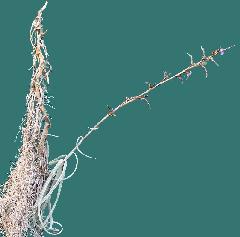
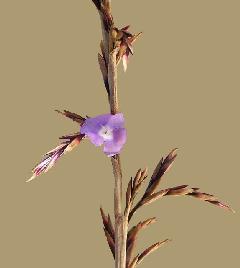
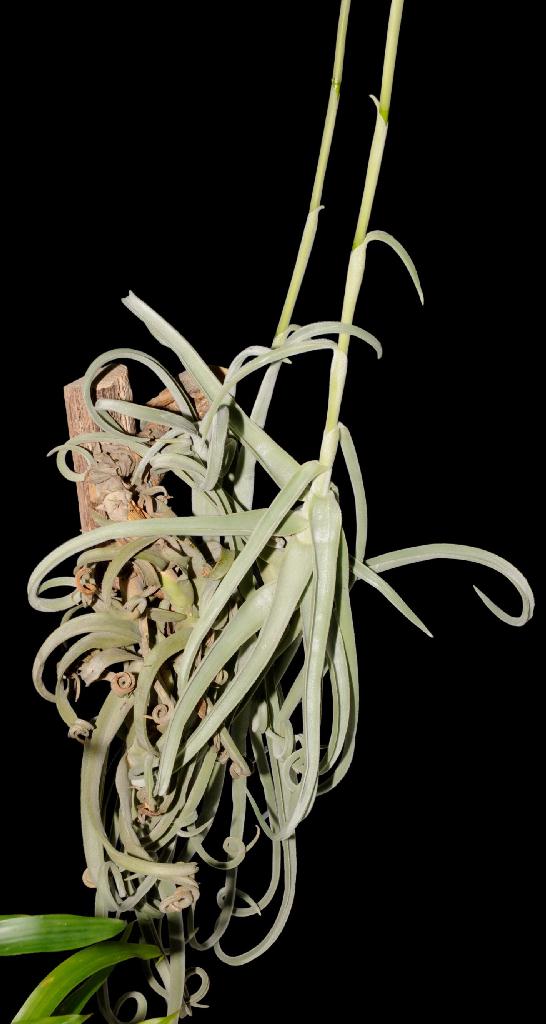
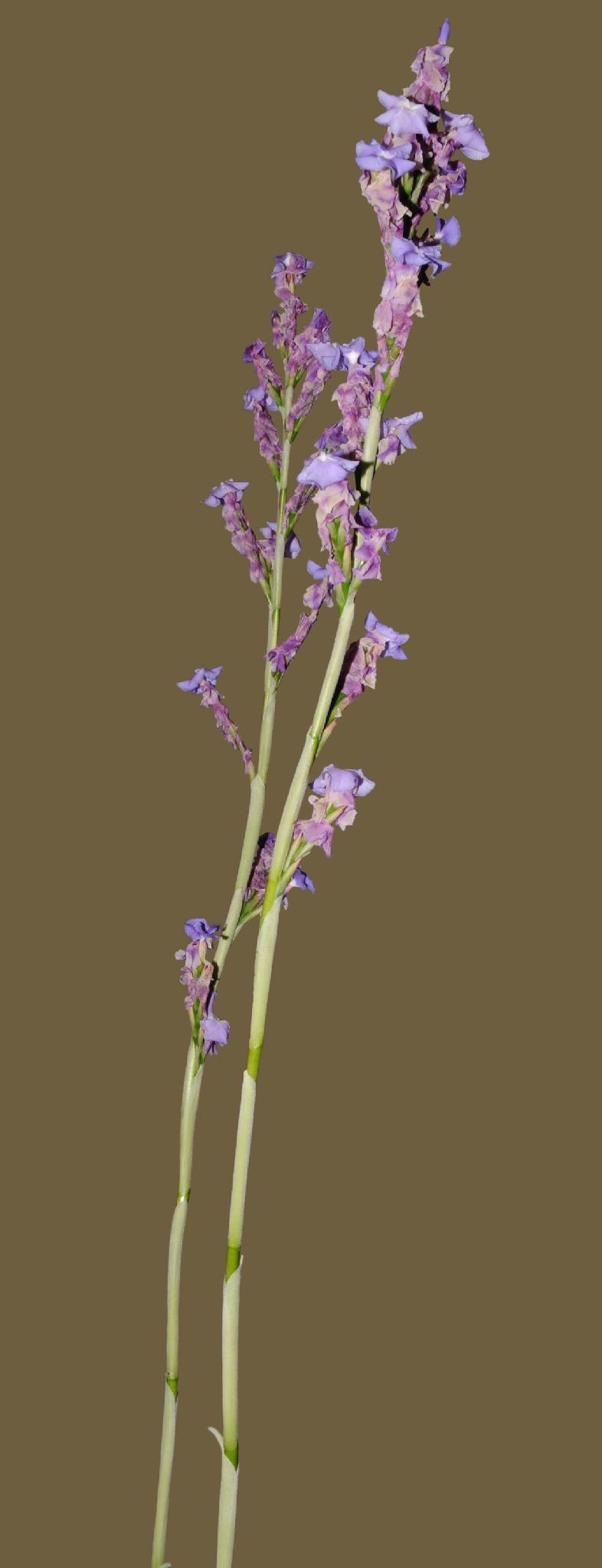
| Mark Supple. var. saxatilis 04/11 |
Paul Smith BSA Show 04/10. Photo Terry Davis. |
Mark Supple ... "This plant I obtained from Peter in 1990 or 91 at Five Dock by memory. It's labelled Tillandsia duratii var saxitilis still have the label, this is the first flowering of this plant and the flowers to date have no fragrance, just a quick question to all. Do any duratii not have fragrance? The flowers have been out now for 2 days. The plant itself is 600mm long and inflorence is 600mm."
Ed. ... "Yes, correct identity. No, ALL duratii have fragrance, especially early morning. But being a "new" sensation, not everyone can pick the smell at first.
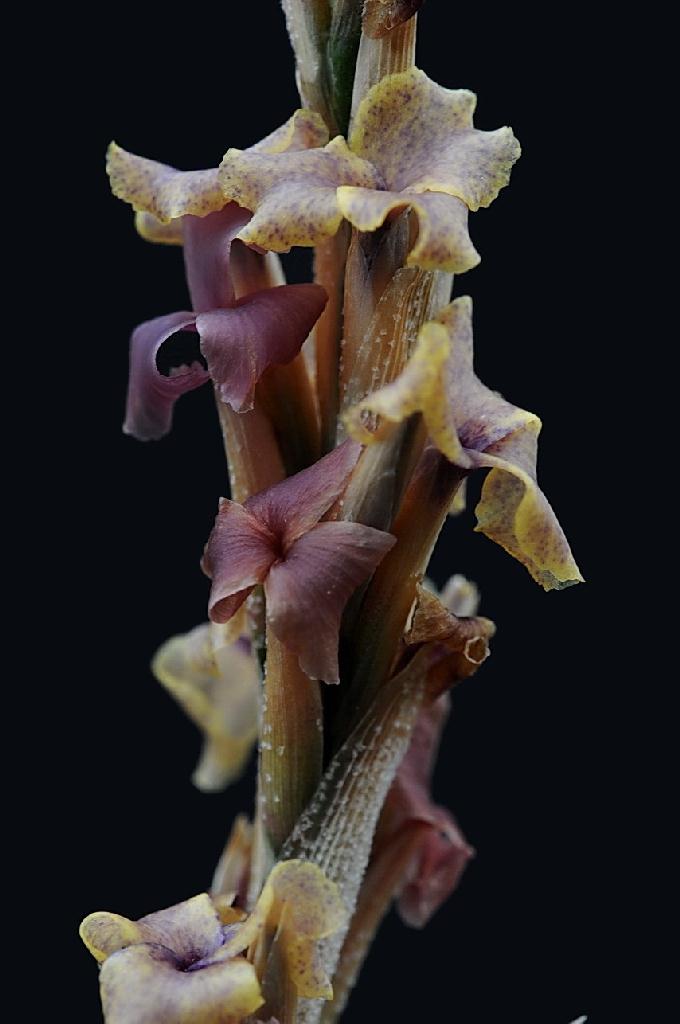
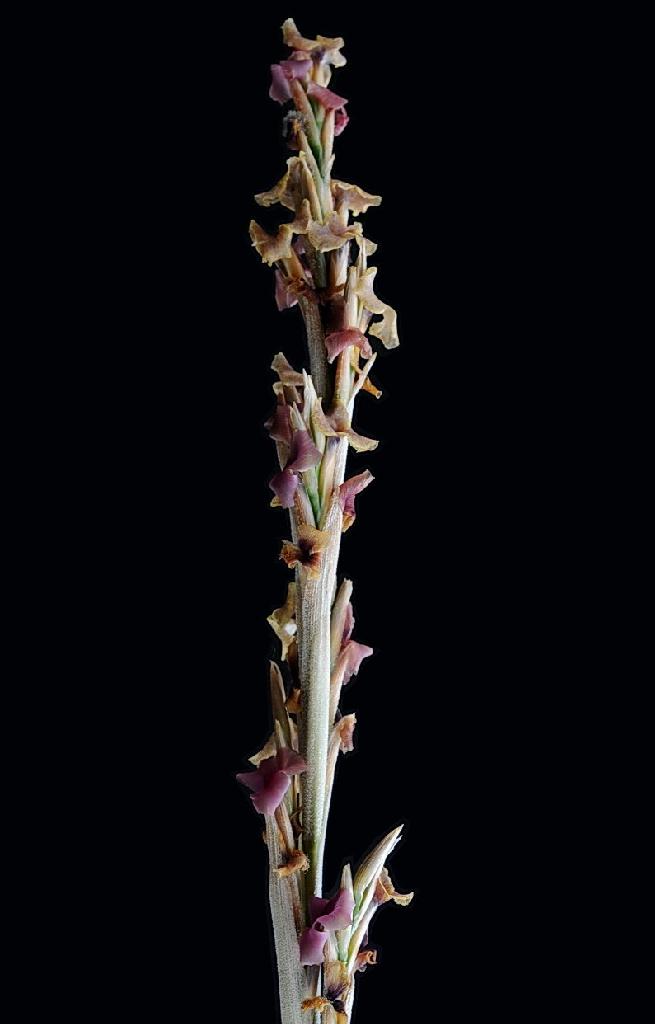
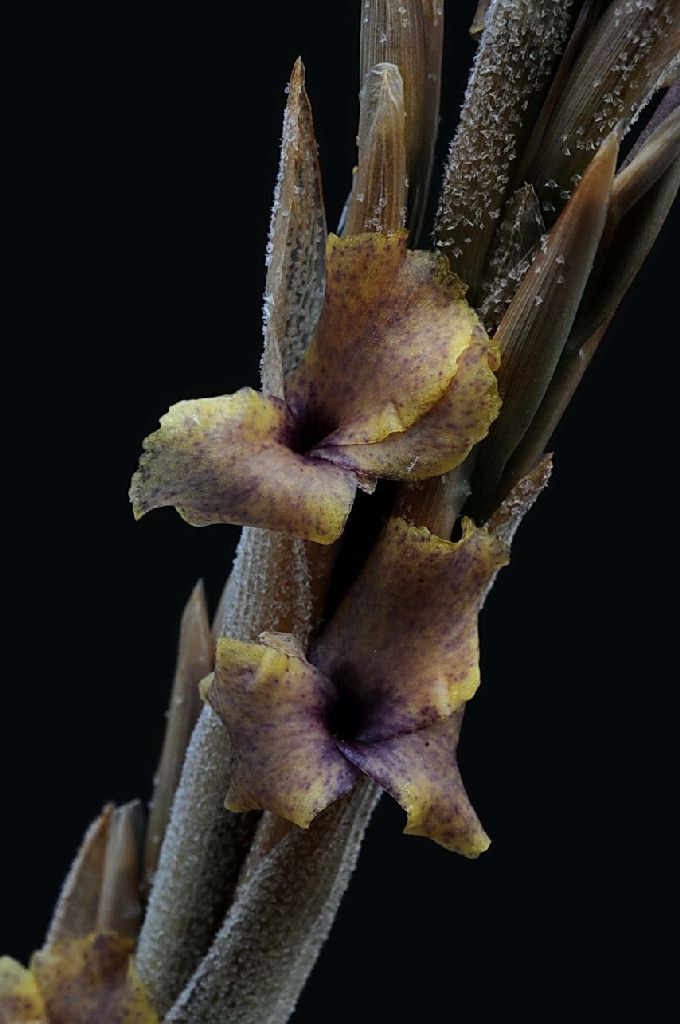
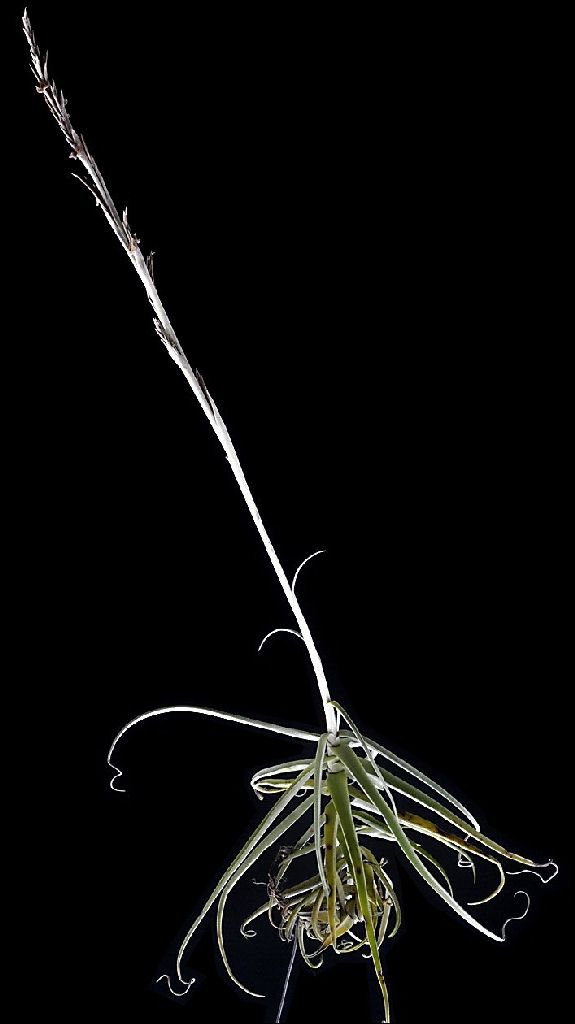
| Peter Tristram 10/11 |
Peter Tristram 10/11 |
Peter Tristram ... "A bit of an update from the previous yellow duratii post. It is interesting that the petals change colour to violet over time and many flowers are open simultaneously – quite a show but from a distance nothing stands out (except the fragrance!). I sure hope this clone is hardier than the other and pups well. Unfortunately the gas killed a couple of its siblings when I imported them – criminal."
Len Colgan ... "Clearly, the T. duratii came from Lotte Hromadnik. I was fortunate to witness the unbelievable location in Bolivia where I was able to find all those different coloured forms of T. duratii, with petal colours including yellow, orange, brown and purple, often mixed. Sadly, all of my plants died in the heat-wave a few years ago. But at least I have wonderful pictures."
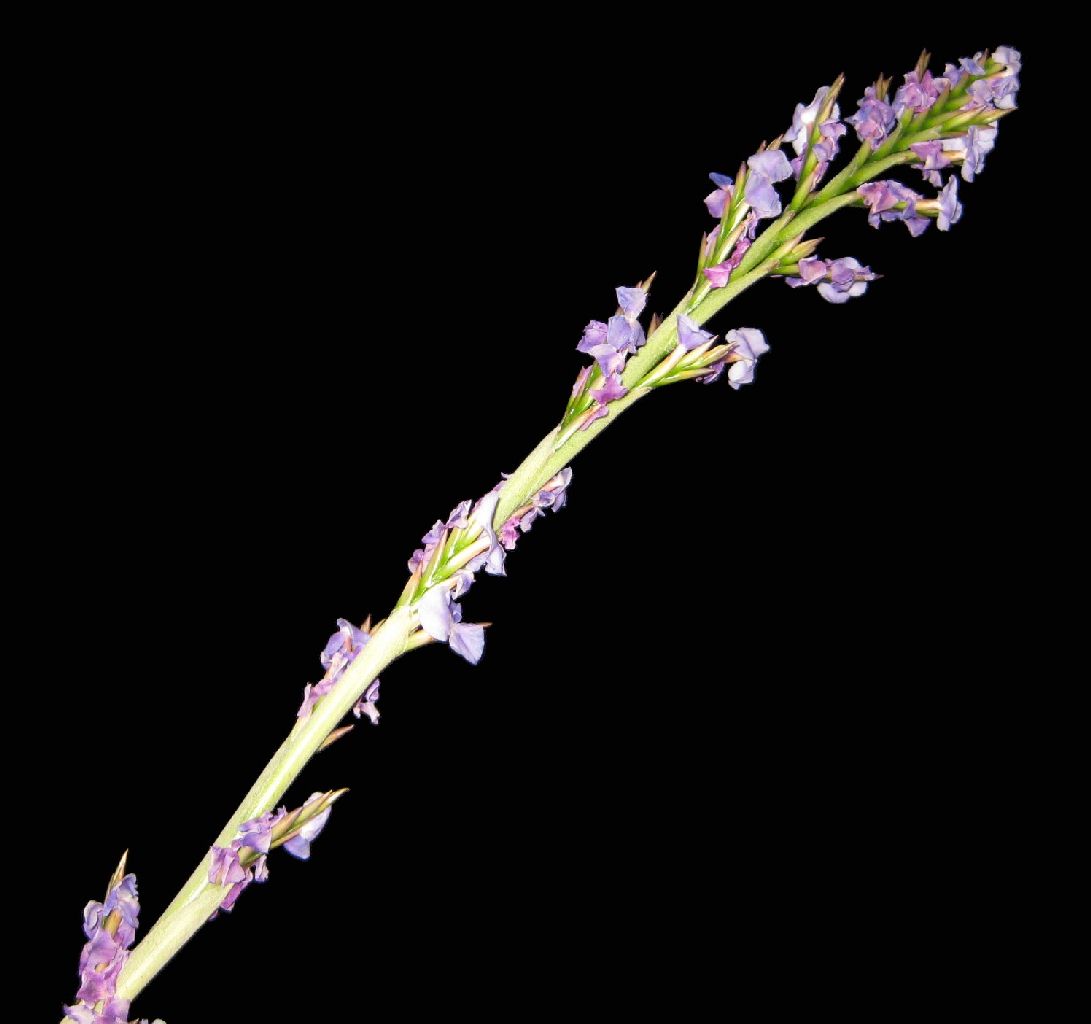
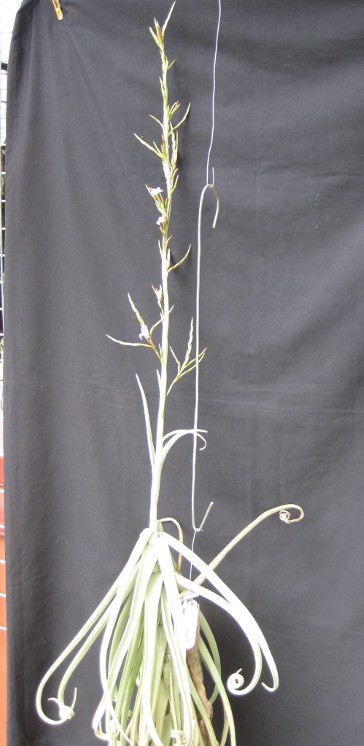
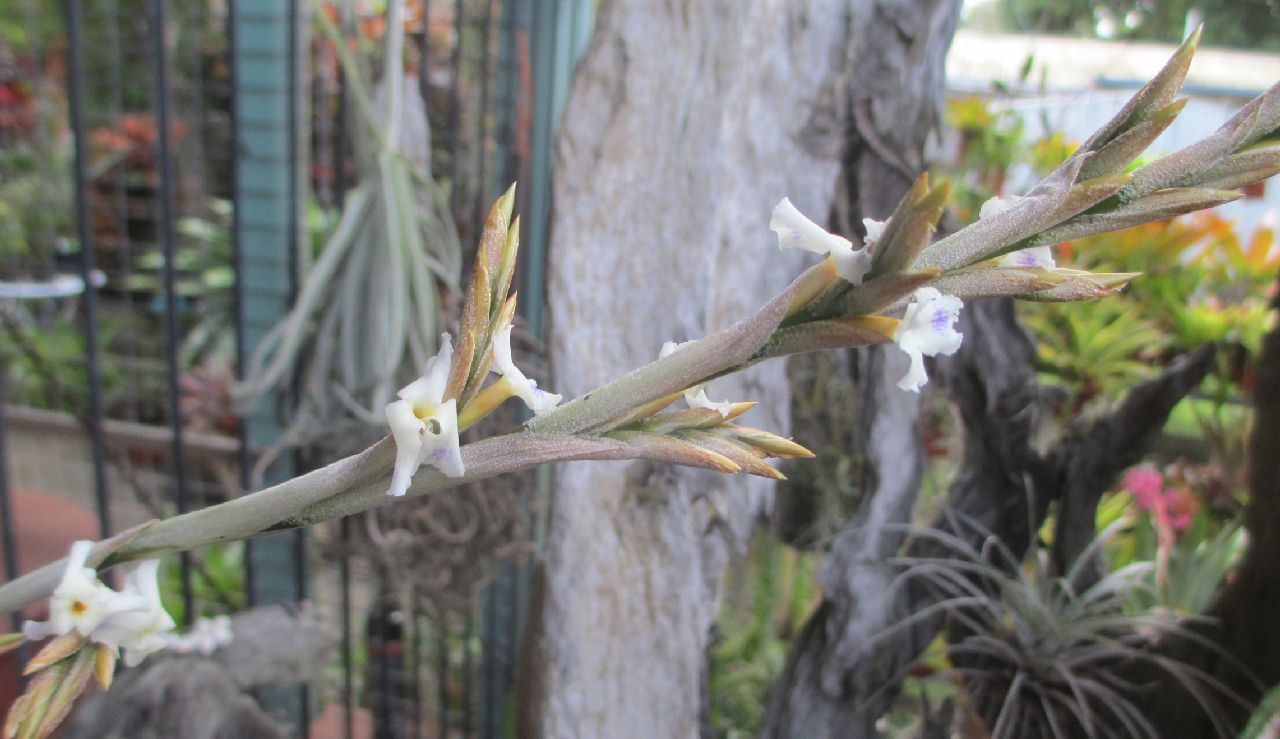
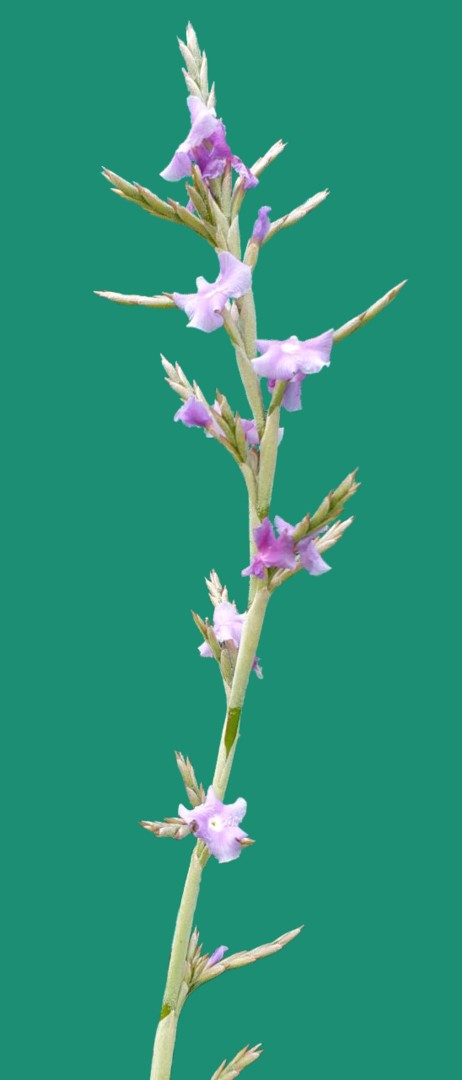
| Bob Hudson 04/12. var. duratii 1m high. |
Bob Hudson 04/12. var. saxatilis 1.6m high. |
Bob Hudson 06/19 var. saxatilis dissapointing |
Pam Butler 03/21 var. saxatilis |
Bob Hudson 06/19 ... "Here is a photo of a disappointing white flowering T. duratii V. saxatilas. The flowers came out blue tipped petals and then faded to white but the petals curled."
Pam Butler ... "Is it a hybrid with the white flowers? It looks pretty good to me."
Bob Hudson ... "No t is not a hybrid I bought this plant from George S whilst in South Africa, when he was selling a few Tillandsias before moving to Australia."
Peter Tristram ... "Interesting history of this duratii too. Most of mine are finishing blooming though a few late maturers are not far off. One is from Lotte as a ‘white’ duratii. It has very white leaves so I bet it’s a normal flowered form and the white refers to the foliage. I hope you’ve got some others to breed with it, so we might get some interesting flower in 10 years."
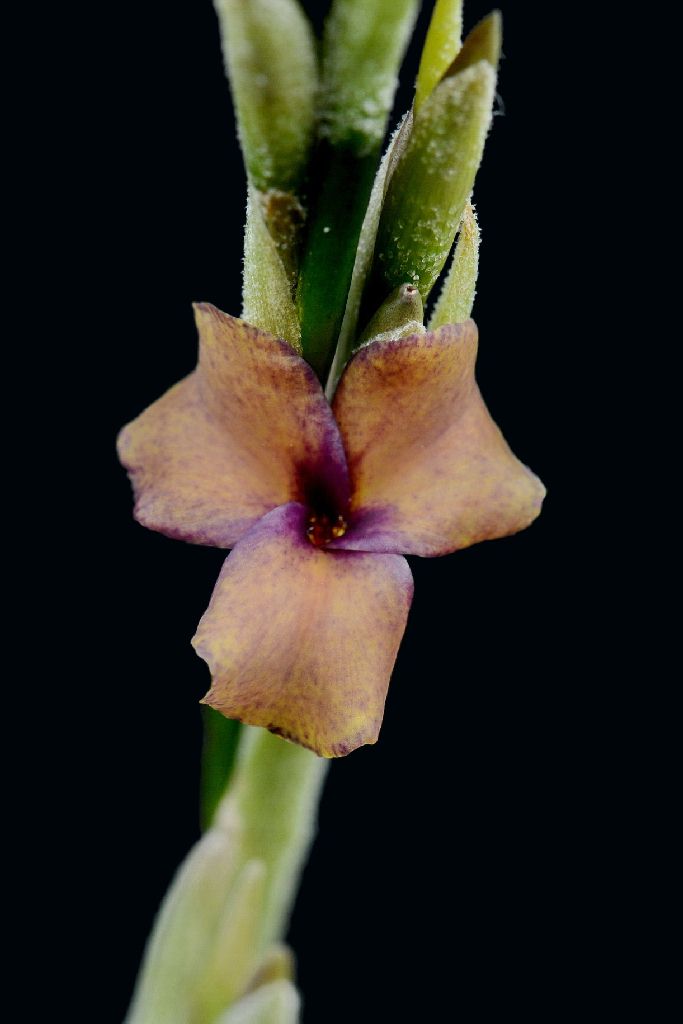
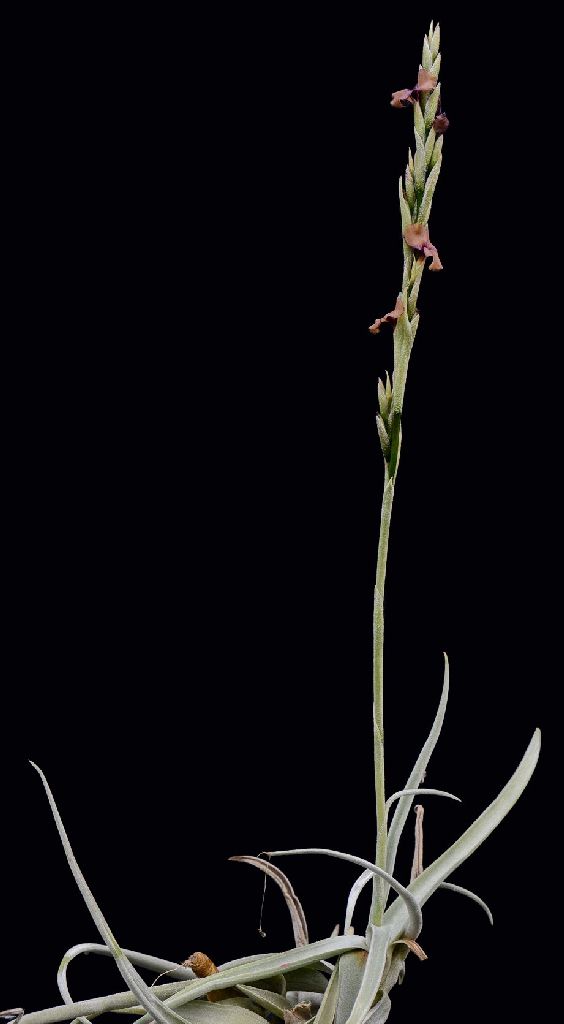
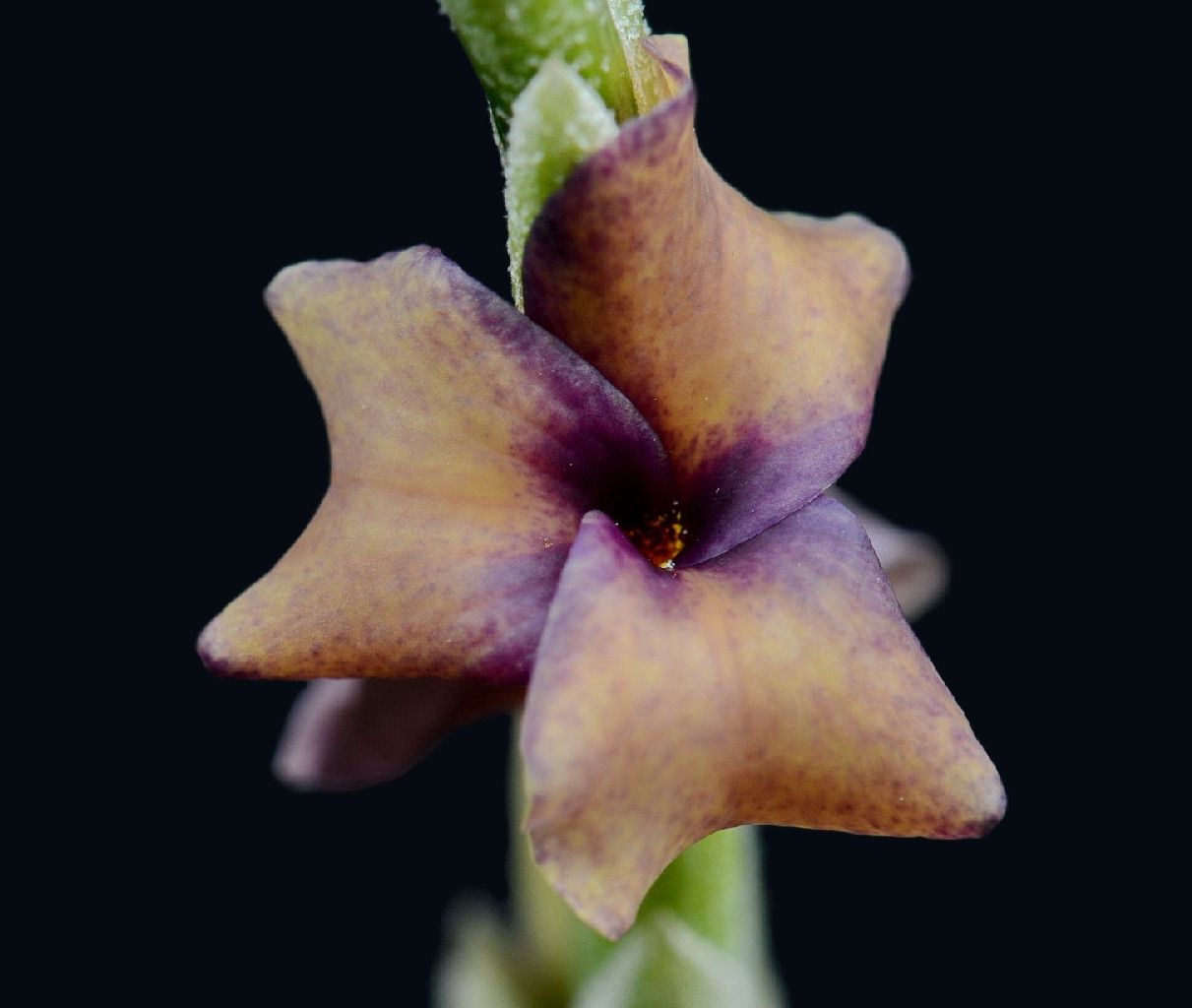
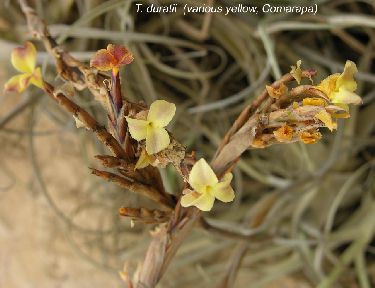
| Peter Tristram 19/01/14 |
Peter Tristram 20/01/14 |
Len Colgan 20/01/14 Comarapa |
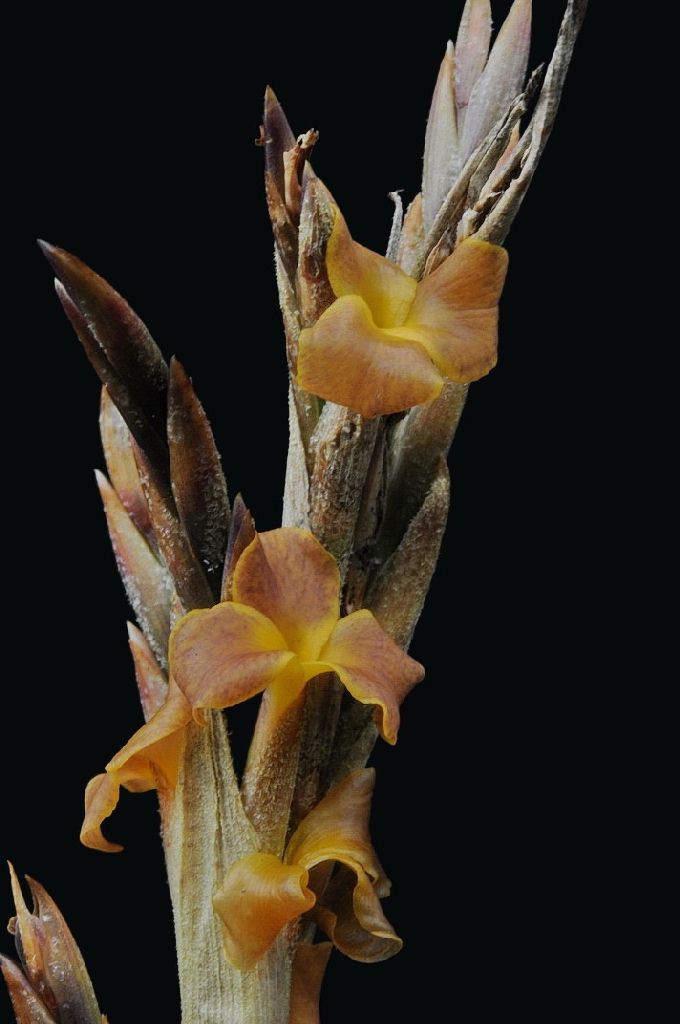
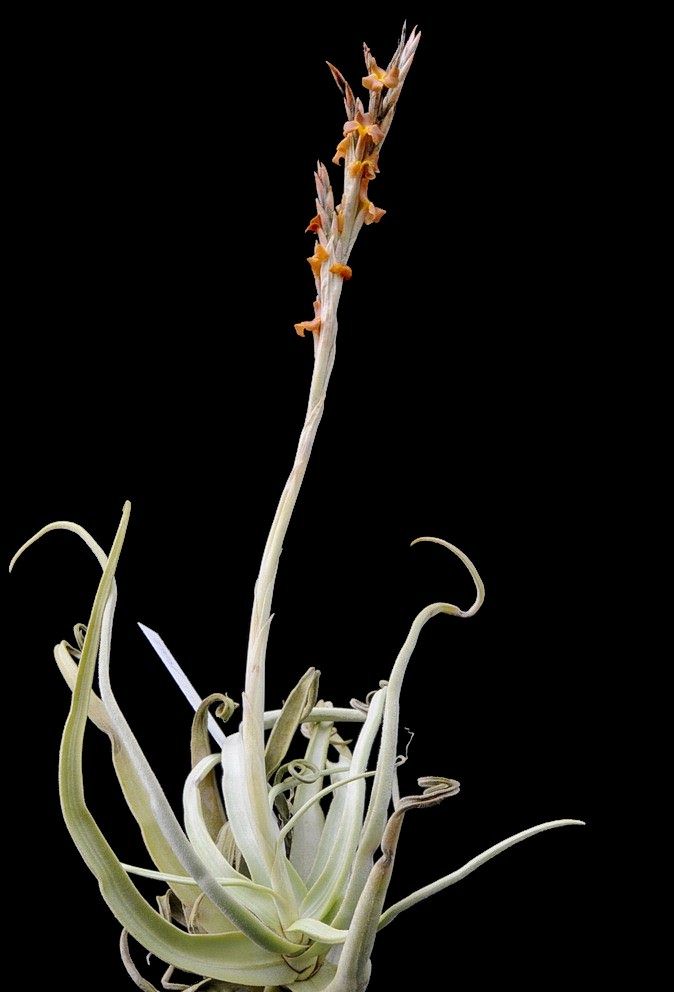
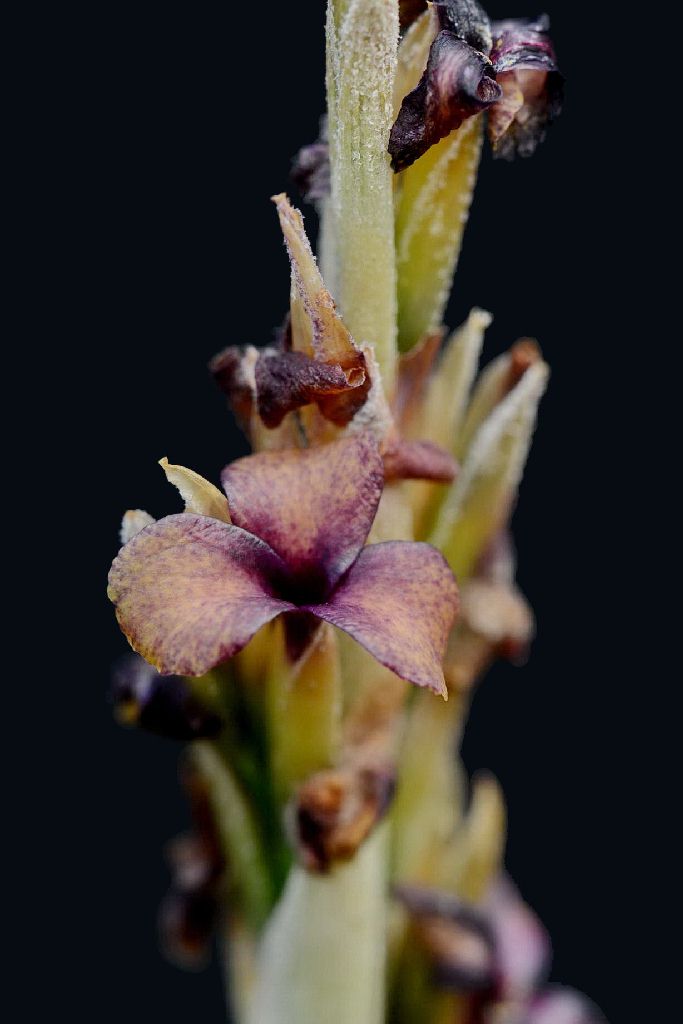
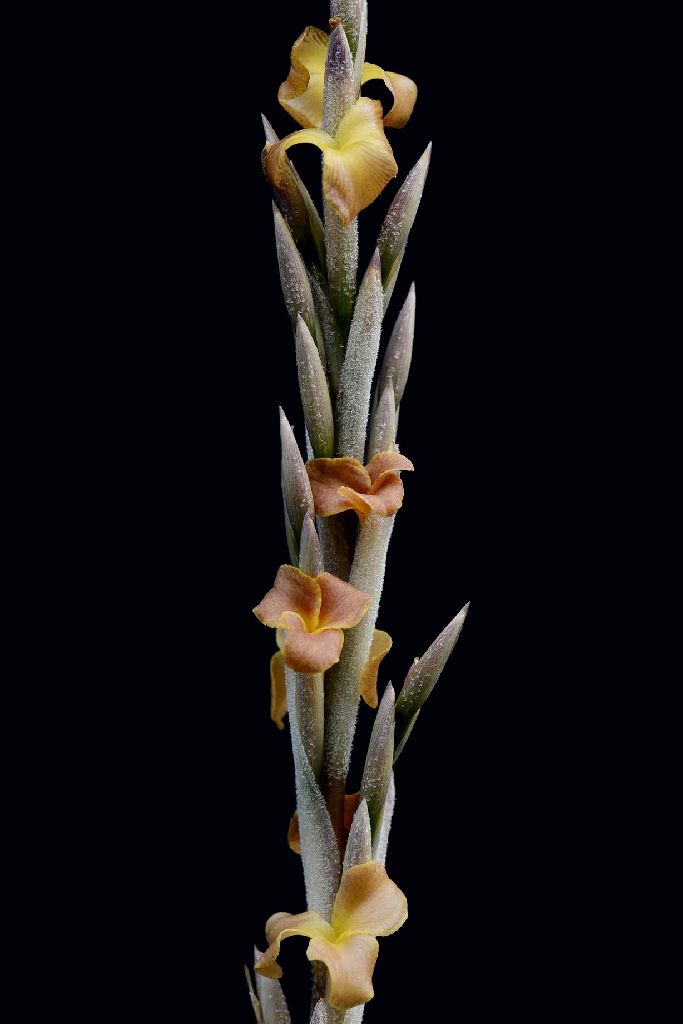
| Peter Tristram 21/01/14 |
Peter Tristram 09/14 |
Peter Tristram 19/01/14 ... "This is the latest clone to bloom of the multi-coloured duratii collected by Lotte (and Len, albeit to have to leave them behind) from near Sucre, Chuquisaca, Bolivia.
They all vary in the yellow/orange and purple content but none have had white centres yet like the usual forms."
Peter Tristram 20/01/14 ... "At least Lotte has shared some clones and I now have some seed finally though this one will bloom alone only to be hybridised.
Hell, they are slow growing (and single pupping) but do bloom regularly. Assuming I can get viable seed fairly often the multicoloured duratii might be pretty common in about 30 years...
I have 2 x 15 mm seedlings from Len's seed a few yrs back. None of last year’s seed (x normal duratii) germinated. A different flower in this pic."
Len Colgan 20/01/14 ... "In case there is someone(?) in this group who has not seen any of my pictures of different coloured T. duratii from Bolivia, I have attached just one image.
It is from a different location (Comarapa) from those involving purple that Peter has shown. The ones I collected involving purple with yellow/orange looked more like T. streptocarpa, I suspect."
Peter Tristram 21/01/14 ... "Hi Len. It is interesting regarding the ‘look’ of these as they vary. A few look more like forms of streptocarpa, except for the inflorescences, with long-tapering, somewhat flat leaf blades, and others look typical duratii with shortish, rolled blades. I notice Lotte has differing locations too but all in Chuquisaca state except for the white one. Notice the altitude variation too.
These are the ones I have that survived Quaranteen (and another, the first one from 2006 that bloomed quite brown and was posted first too and looks typical duratii v. duratii, but I can’t find the data just now – pics attached. It bloomed once and gave 1 pup which I removed but promptly died then another which I wasn’t game to remove):
Yellow to violet - 30/07/1979, 5260, T. duratii v. duratii, yellow to violet, 2600m, Tarabuco, Presto, Chuquisaca, Bolivia
Dark violet yellow - 30/07/1979, 5253, T. duratii v. duratii dark violet, gelb, 2400m, Zudanez, Chuquisaca, Bolivia
White - 16/07/1979, 5031, T. duratii white from seeds, 1700m, Puente Arce, Cochabamba, Bolivia
Yellow (Technicolor one I just posted) - 14/02/1995, 19062, T. duratii v. duratii, gelb, 3000m, Paß nördl. Sucre, Chuquisaca, Bolivia
Yellow/orange – 27/2/99, 24009, T duratii v. duratii, gelb, 2400m, oberh. Villa Serrano, Chuquisaca, Bolivia
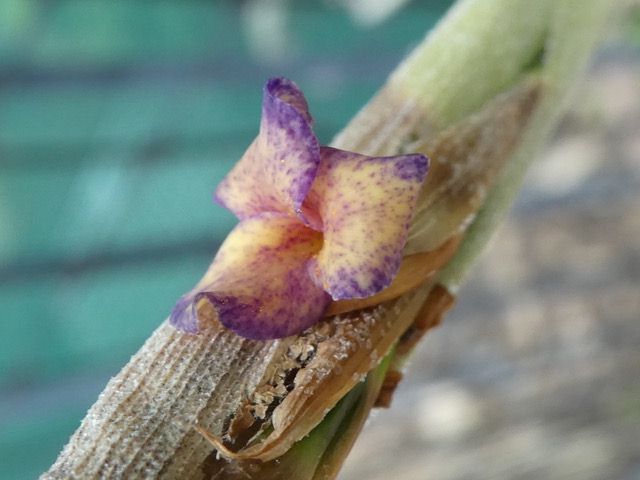
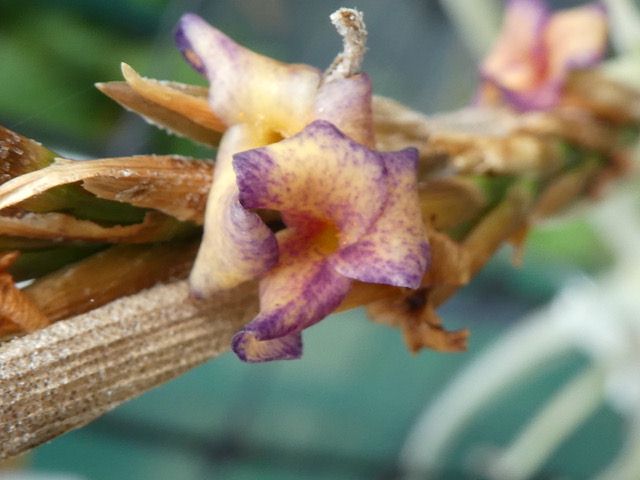
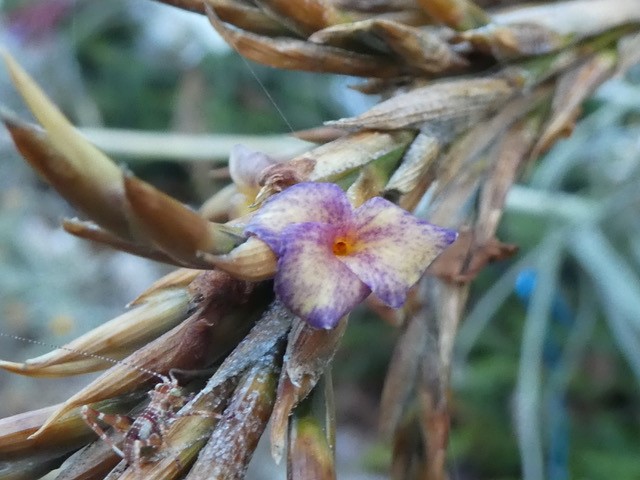
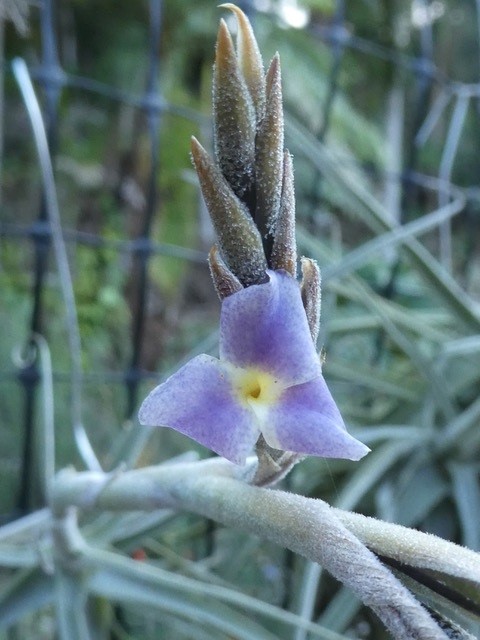
| Bruce Dunstan 09/20 Yellow/violet |
Bruce Dunstan 08/21 This year I have another clone to play with |
Peter Tristram 09/14 ... "This year a couple of new forms of the yellow flowering duratii are in bloom. Needless to say I have been cross-pollinating these three different clones so that these interesting plants can be propagated from seed. Last year’s seed has just been sown so I will know its viablility very soon. So far these forms have proven very difficult from seed with most not germinating, compared to normal duratii forms that grow like weeds. Mind you I haven’t had lots of flowers to play with until last year."
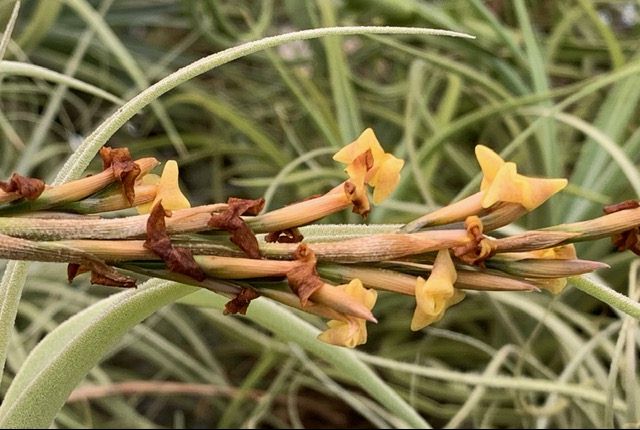
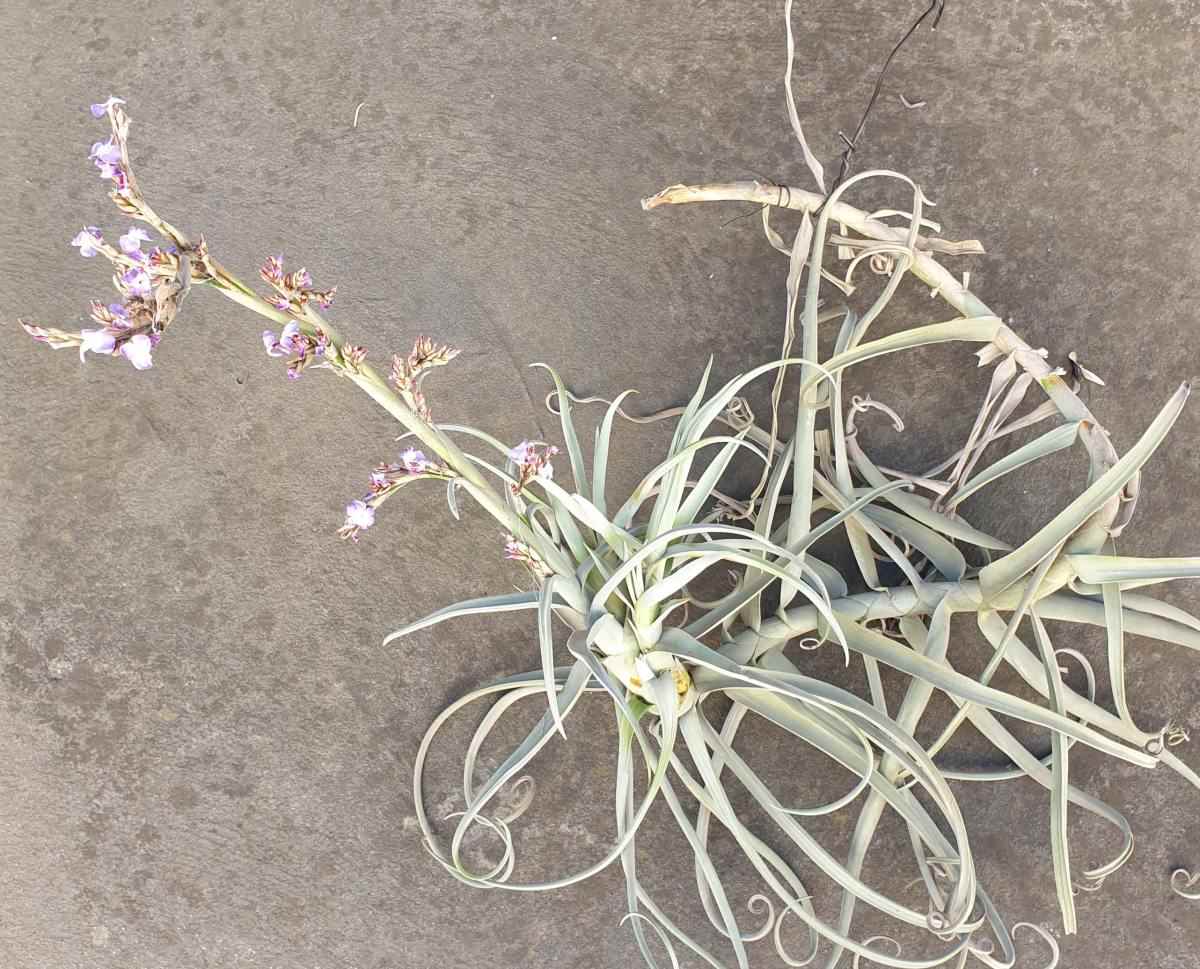
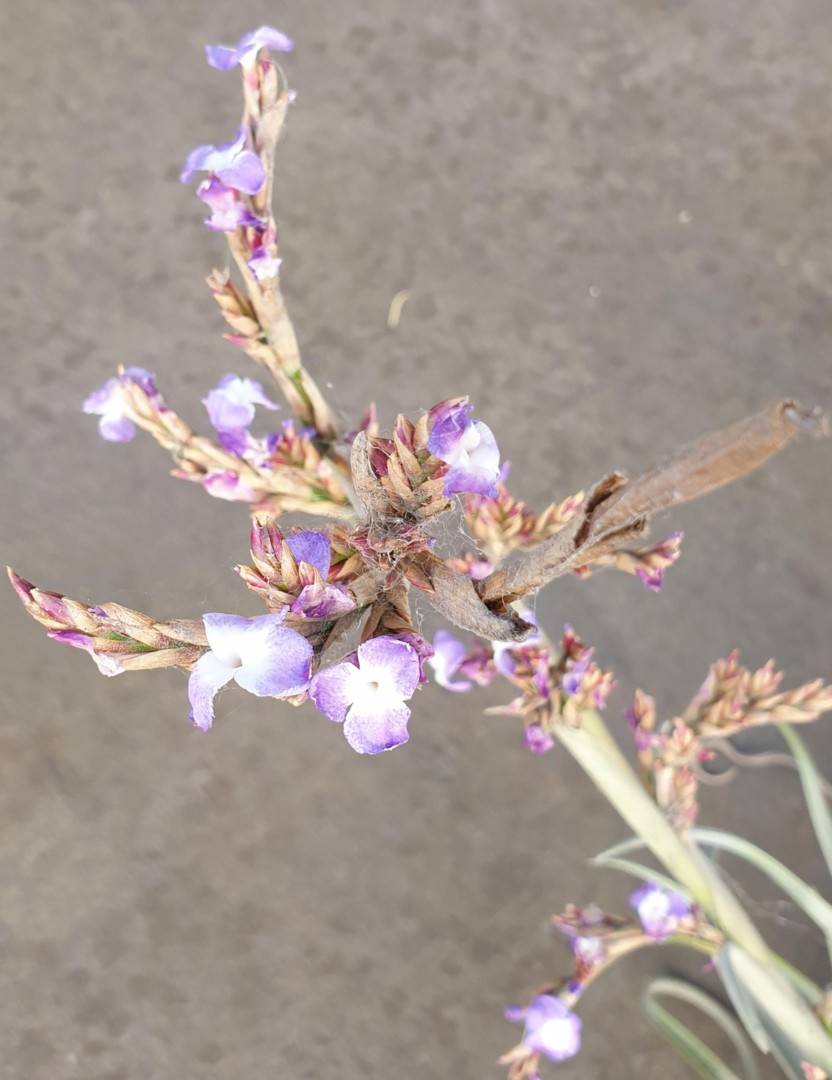
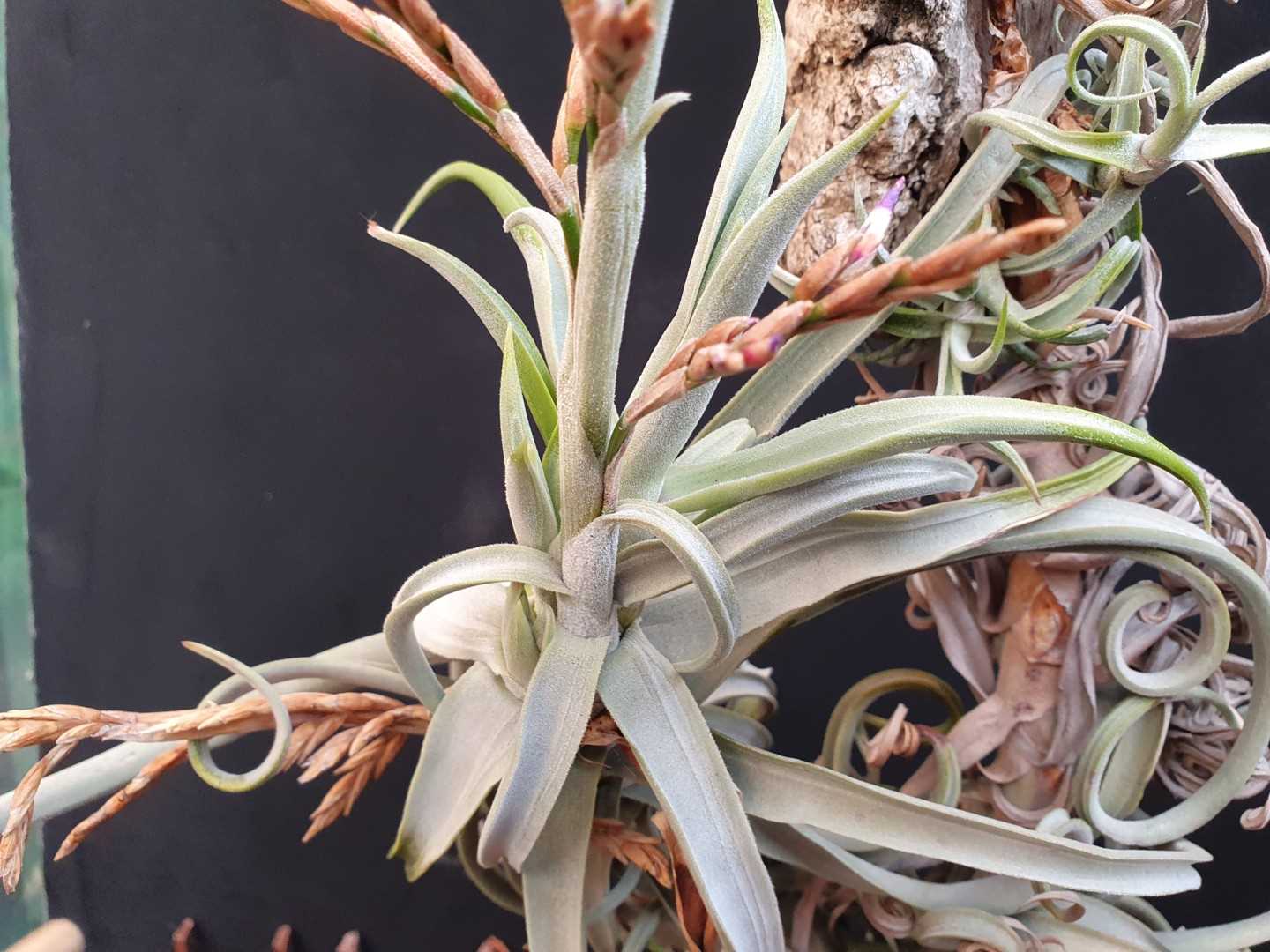
| Peter Tristram 09/19 |
Chris Larson 12/20 var saxatilis |
Geoff Beech 12/20 var saxatilis |
Peter Tristram ... "The fragrance of this nice yellow duratii, ex Lotte, gave its blooming on a bench away. Imagine the thrill Len Colgan had seeing the population where this multicoloured form grows, in Bolivia."
Chris Larson ... "This T. durattii var saxitilis was ready to flower before the winter hit. It sits on the fence & gets full sun from around 9 or 10 until 12 - with no overhead coverage, from rain or sun.
In May, the spike was fully developed - or rather all but the flowers. Then, with the onset of spring, the pups started developing. I thought the flowering process was over - that it had aborted. Then, approx 3 weeks ago, the flowers started popping out. I have 2 others on the same stretch of fence that are doing the same."
Geoff Beech ... "Chris: It must be something in the Melbourne water. This one has also been in spike all winter and produced 3 offsets before flowering"
Chris Larson ... "How it swaps between flowering, then to the pupping, then back to flowering, is something I don't see often in plants (or should I say notice) which are not known for readily pupping prior to flowering. I find these things are often an aberration, and don't re-occur. However in this instance it has happened in 3 T. duratii growing in this same location."
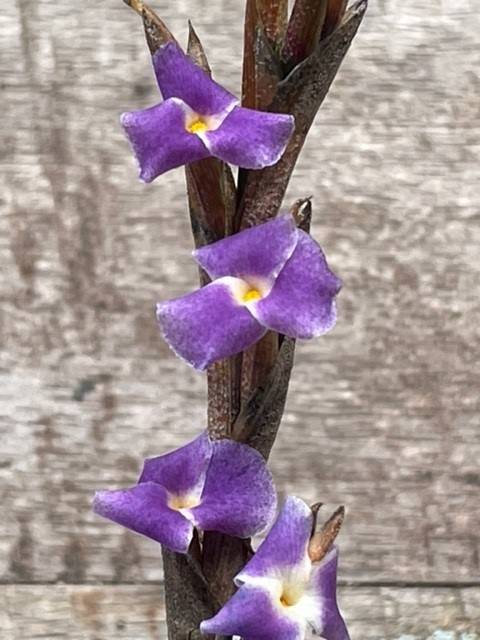
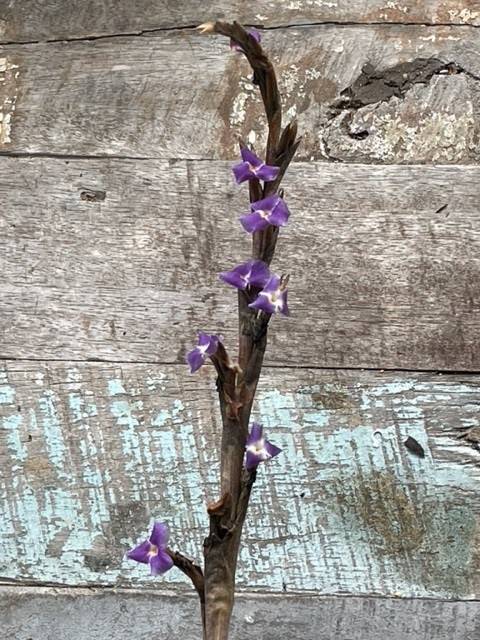
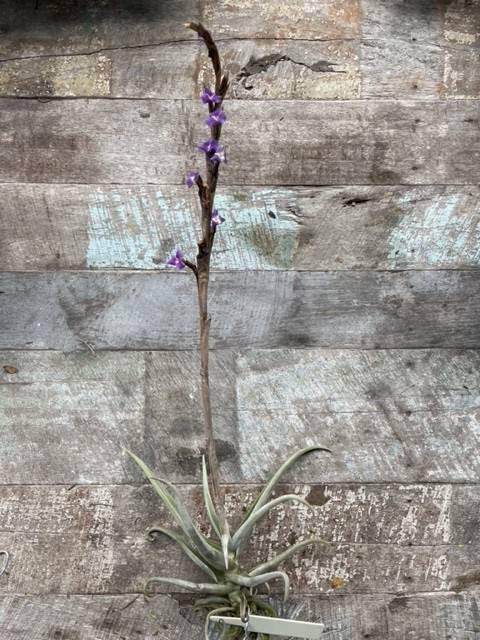
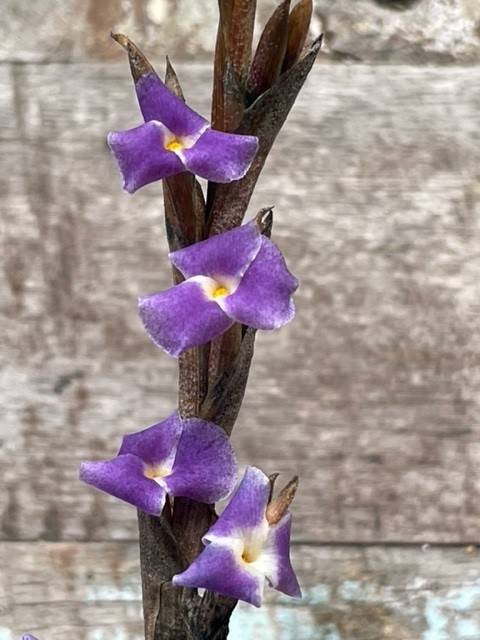
| Bruce Dunstan 05/22 (var saxatilis?) "Giant Tropiflora" |
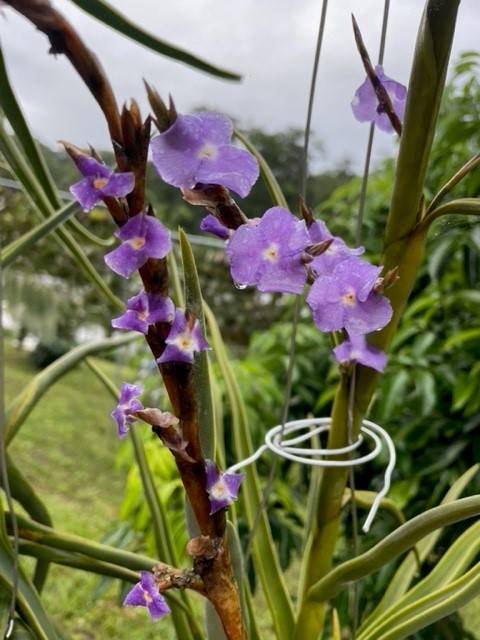
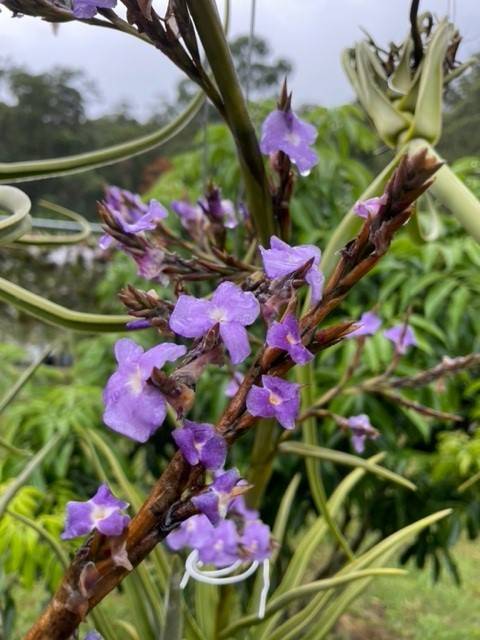
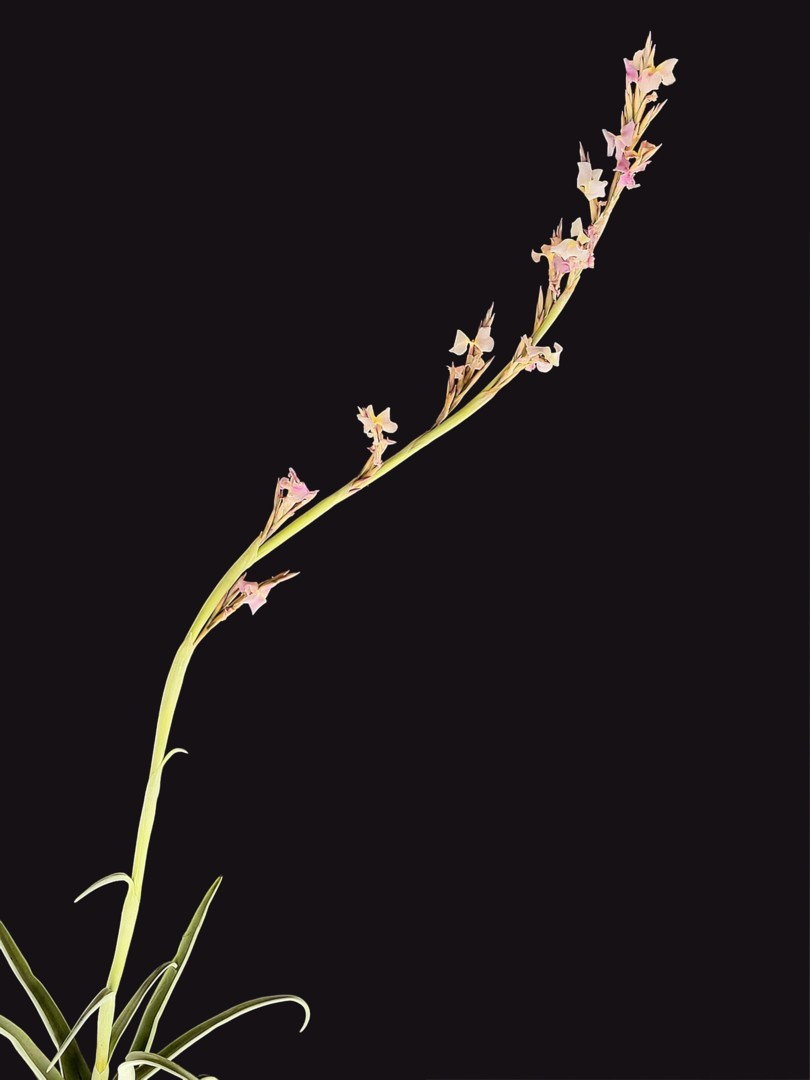
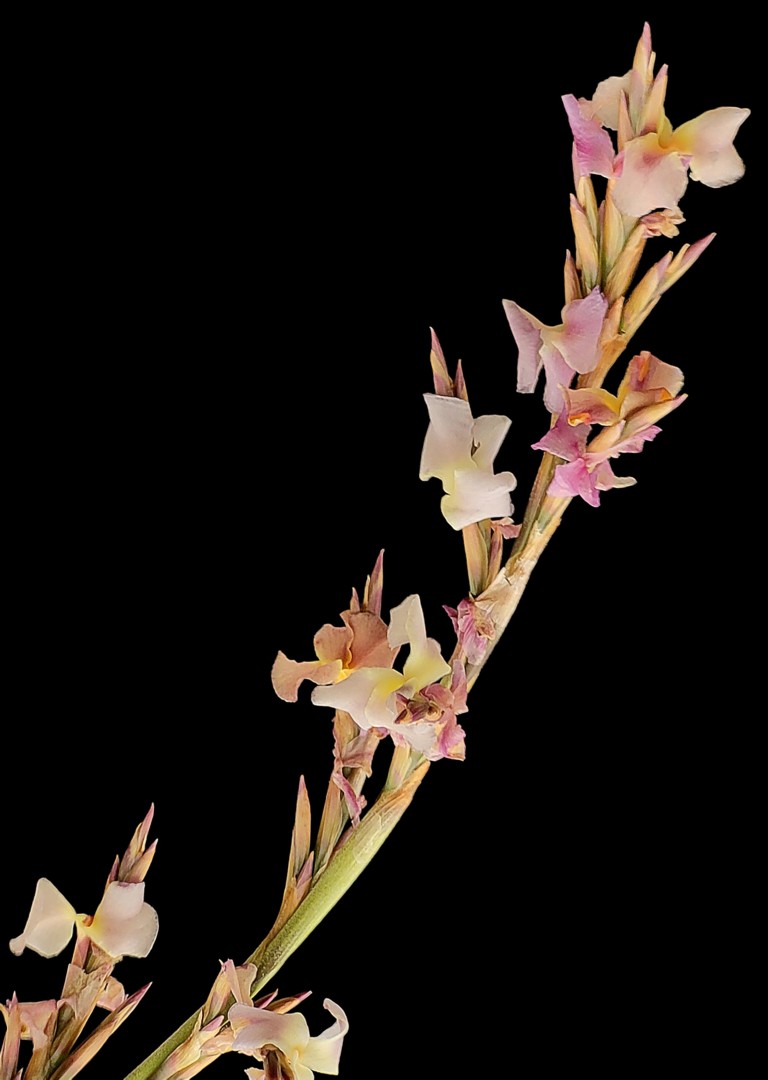
| Bruce Dunstan 05/22 var. saxatilis |
Peter Tristram 08/22 different coloured var. saxatilis ex Lotte |
Bruce Dunstan 05/22 ... "First flowering of this seedling from Barry Genn. Labelled 'Giant Tropiflora'. It has noticeably smaller and darker flowers than all the standard var saxatilis I have flowered over the past few years. The last 2 images are comparisons with var saxatilis. It looks to have flowered a little early but then I noticed another individual is also in bud."
Pam Butler ... "Bruce, do you think it could be a hybrid??"
Bruce Dunstan ... "Pam: Speaking briefly with Barry Genn, he thought it may have some affinity to var duratii.
I have a couple from him that are labelled var duratii that Pam Koide Hyatt thought looked like var duratii and they are getting much bigger and still yet to flower. They are closer in foliage form to this small one so I guess time will tell one day."
Peter Tristram 08/22 ... "A colourful form from Lotte, more like a typical medium sized duratii v saxatilis than the distinctively different yellow, violet, orange, etc. forms."
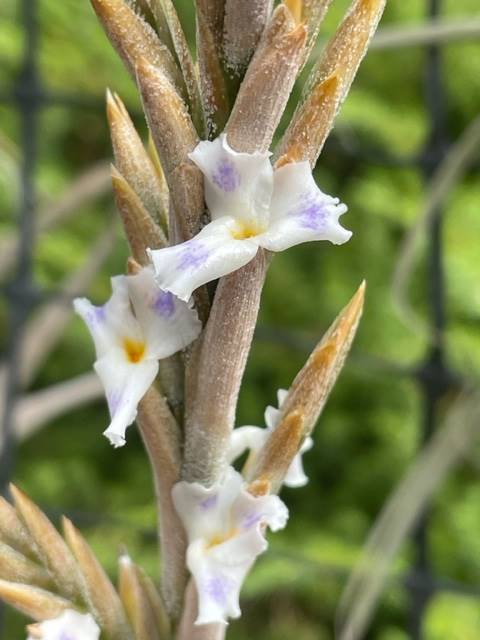
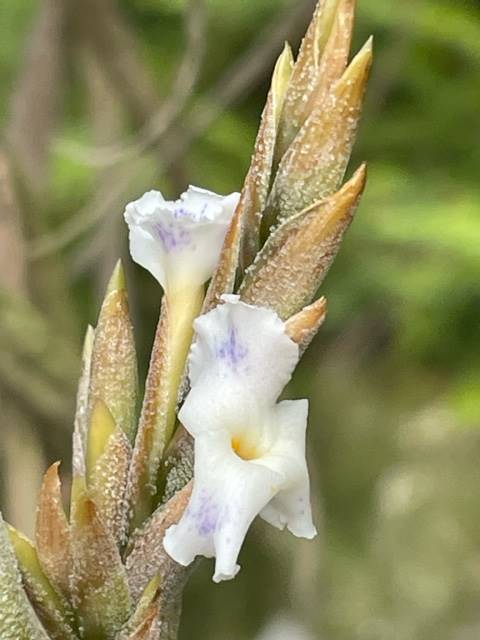
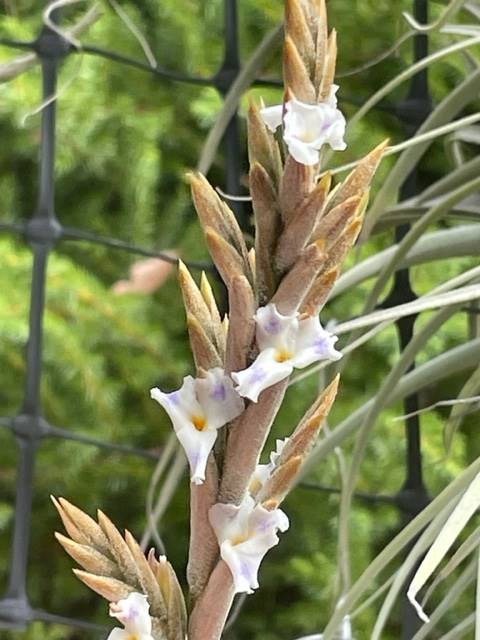
| Bruce Dunstan 04/23 var saxatilis ex. Bob Hudson |
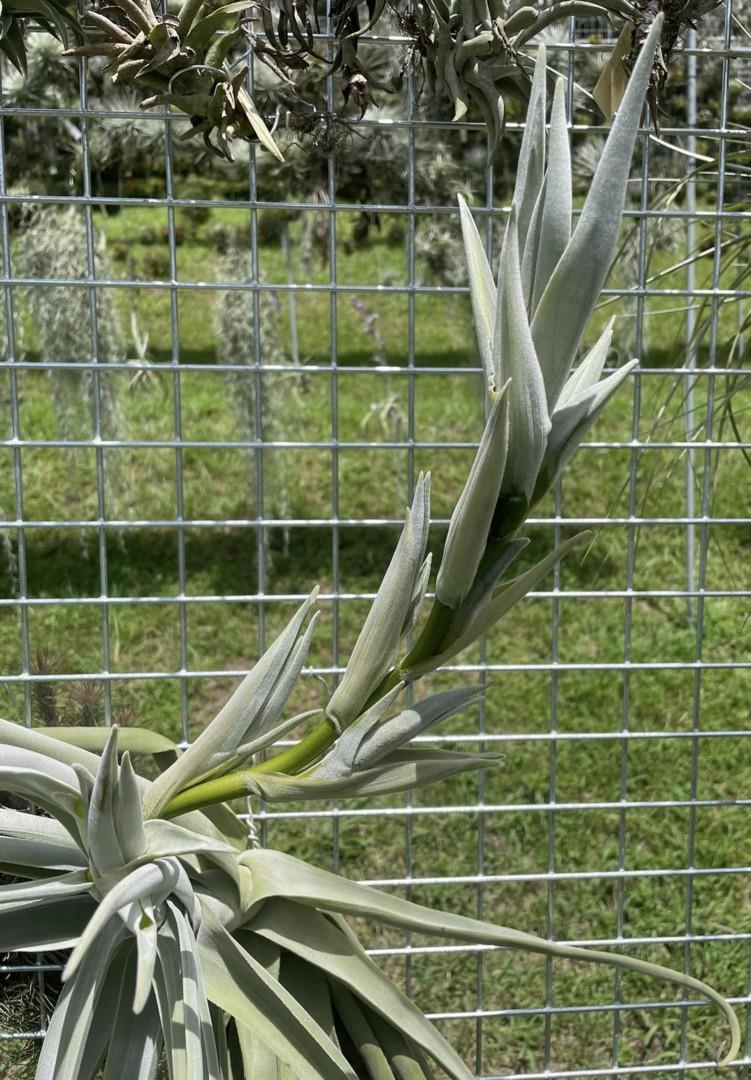
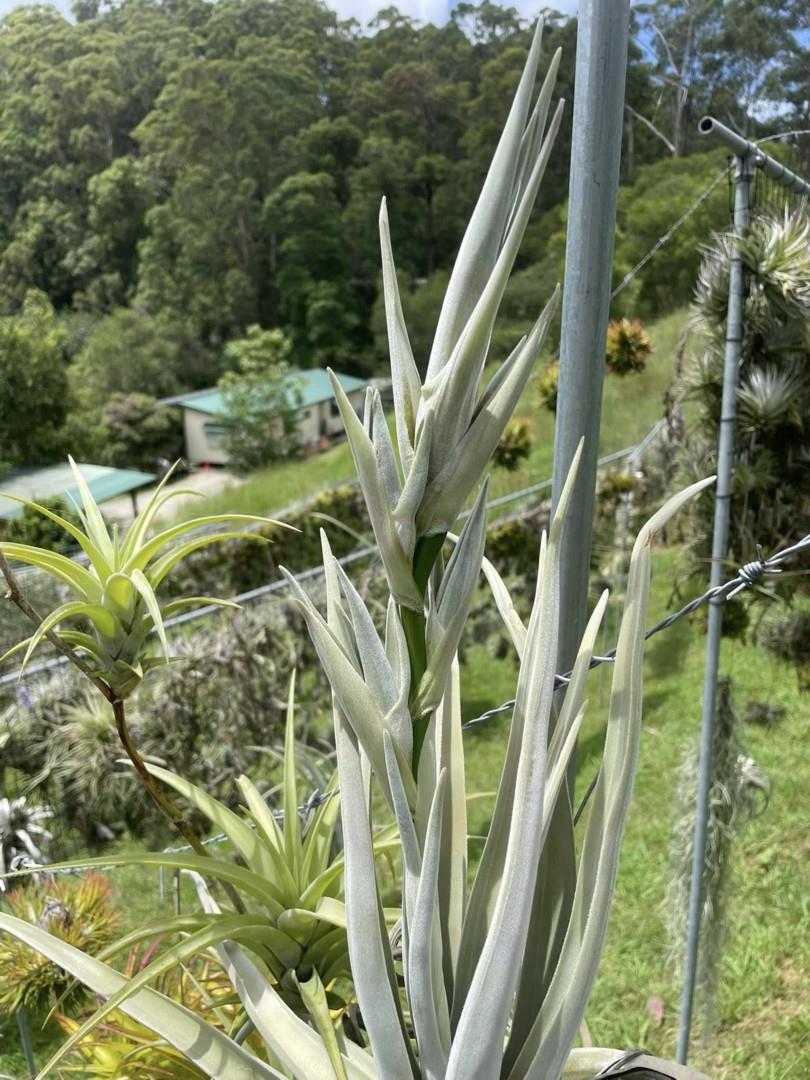
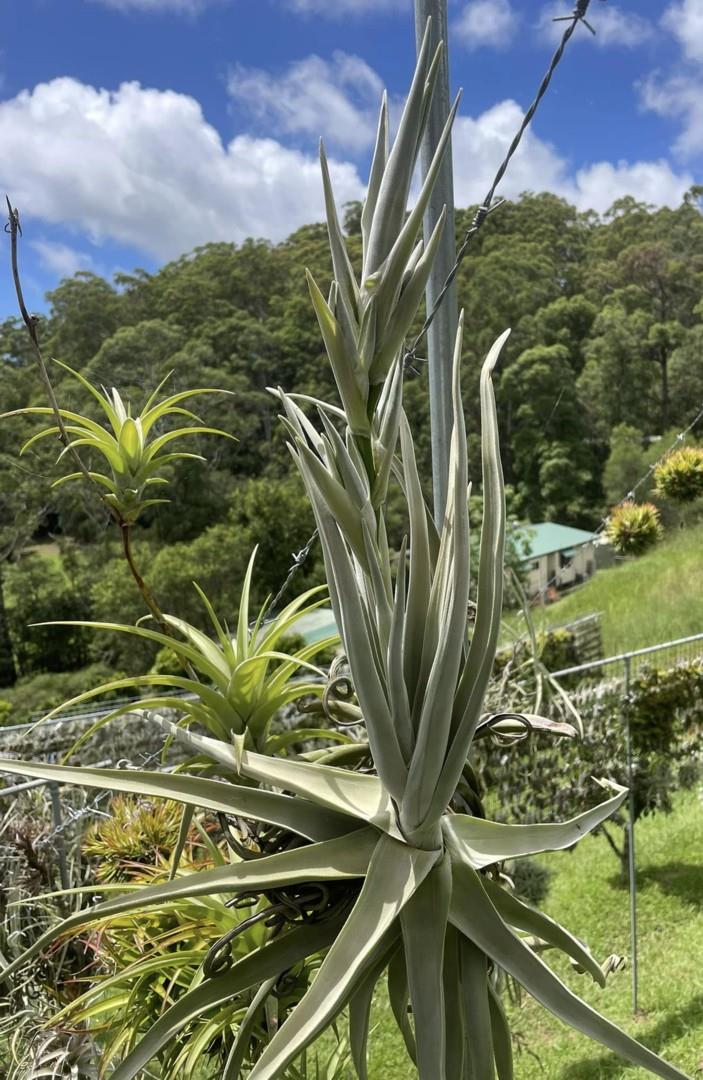
| Bruce Dunstan 02/25 var saxatilis - pseudoviviparous |
Bruce Dunstan ... "duratii var saxatilis. Doing the pseudoviviparous thing. I had one last year and 3 this year"
Bruce Dunstan ... ""
Tillandsia duratii Visiani, Ill. Piante Nuove Ort. Bot. Padova in Nuovi Saggi Padova 5: 271, pl. 29. 1840.
Desc from S&D p859-863
Plant caulescent, flowering from 2 dm to over 1 m; roots present at first; stem stout, curved, simple, to 3 dm long.
Leaves densely polystichous along the stem, covered with appressed or subappressed coarse cinereous scales;
Sheaths distinct, broadly ovate, ca 2 cm long;
Blades very narrowly triangular, involute-subulate, 1-2 cm wide, spirally recurved around tree branches, rigid, thick, pungent.
Scape erect, elongate, stout, glabrous;
Scape-bracts closely imbricate, elliptic, densely cinereous-lepidote, the lower linear-laminate, the upper apiculate.
Inflorescence 2-3-pinnate, 6-60 cm long;
Primary bracts like the upper scape-bracts, erect and enfolding the bracteate sterile bases of the branches;
Branches strict to spreading or decurved; spikes lanceolate to linear, complanate.
Floral bracts erect, ovate or elliptic, to 14 mm long, slightly shorter to slightly longer than the sepals, ecarinate;
Flowers subsessile, fragrant.
Sepals ovate or elliptic, subobtuse, unequally short-connate, to 14 mm long, coriaceous, even, glabrous;
Petals 25 mm long, the blades spreading, suborbicular, usually blue;
Stamens deeply included, exceeding the pistil.
Tillandsia duratii var duratii
Tillandsia floribunda Durat ex Visiani, Nuovi Saggi Padova 5: 271.1840; nomen; non Humboldt, Bonpland & Kunth 1816.
Phytarrhiza duratii (Visiani) Visiani, Preprint 7.1854; Mem. Ist. Ven. 5: 340, pl. 1855. Anoplophytum duratii (Visiani) Beer, Bromel. 42. 1857.
Tillandsia circinalis Grisebach, PI. Lorentz., Gott. Abh. 19: 272. 1874. Type. Rio Primero, Sierra de Cordoba, Cordoba, Argentina, Lorentz 512 (B, CORD, GOET), Sep 1871.
Tillandsia gigantea Ruchinger, Cat. 1876; Ruchinger ex Baker, Handb. Bromel. 166. 1889; nomen.
Phytarrhiza circinalis E. Morren ex Baker, Handb. Bromel. 166. 1889; nomen.
Tillandsia revoluta Burbidge ex Baker, Handb. Bromel. 166. 1889; nomen.
Inflorescence largely bipinnate;
Spikes strict.
Floral bracts densely and persistently lepidote.
Type. Padua Hortus s n (holotype PAD ? n v). In the absence of any specimen the species is adequately typified by the original description and illustration.
DISTRIBUTION. Epiphytic in dry woods, 300-1310 m alt, Bolivia, Paraguay (?), Uruguay, northern Argentina.
BOLIVIA. TARIJA: Villamontes, Yaquacuna, Chaco, 12 Oct 1927, Troll 387 (M); without exact locality, 1846, Weddell 403 5 e p (P). PARAGUAY (?). Without exact locality, Miers 1365 (BM). URUGUAY. ARTIGAS: Arroyo Tigre, 1938, Lombardo 2912 (GH). SALTO: Espinillar, Oct 1958, Klappenbach s n (MVM); without exact locality, Dec 1924, Schroeder in Osten 17766 (MVM). ARGENTINA.Jujuy: San Pedro, 30 Sep 1938, Eyerdam & Beetle 22329 (GH); Cuestal de las Lajitas, Capital, 26 Jul 1963, Cabrera 15908 (LP). SALTA: Dragones, Aug 1873, Lorentz & Hieronymus 604 (BM, GH); Sierra de la Candelaria, 3 Sep 1929, Venturi 9499 (BM, GH, US). CATAMARCA: Capital, 10 Aug 1909, Castillon1804 (GH, LIL); Rio del Valle, 13 Sep 1910, Castillon s n (GH, LIL, US); El Alto, 6 Oct 1964, Hunziker & Cocucci 17498 (CORD). TUCUMAN: Burruyacu, 6 Feb 1903, Stuckert 12803-B (G); 8 Sep 1923, Venturi 2499 (US); Tapia, Trancas, Ju1 1919, Schreiter 807 (GH, LIL, MVM, NY); 22 Aug 1920, Venturi 1048 (GH, NY, US); 5 Sep 1922, 1048-C (MVM); Vipos, Trancas, 6 Sep 1925, Schreiter 6581 (GH, LIL, NY); Santiago del Estero line, Leales, 2 Oct 1922, Venturi 1915 (GH, US); Sierra Candelaria, 29 Ju11924, Venturi 2499-A (US). SANTIAGO DEL ESTERO: Dean Funes, 1910, Willis s n (US); Sotelo, Oct 1915, De Carles 27/1122 (GH, BA); Sierra de Guasayan, Choya, 9 Dec 1964, Hunziker & Cocucci 17899 (CORD). FORMOSA: Pozo del Tigre to Laguna San Luis, 25 Feb 1951, Ragonese & Castiglione 7945 (BAB). CHACO: Taco Pozo, 15 Ju11933, Cabrera 3170 (GH, NY); Colonia Benitez, Mar 1935, Schulz 809 (GH); Reconquista Santa Fe, Aug 1934, Schulz 823 (GH); Fontana, Nov 1938, Meyer 4 (GH). LA RIOJA: Sierra de Velasco, Sanagasta, Feb 1944, Job 1838 (US); 29 Jan 1965,Hunziker & Cocucci 18154 (CORD). SAN JUAN: San Agustin de Valle Fertil, 31 Jan 1943, Bartlett 19547 (MICH). SAN Luis: Baio de Velis, Sierra San Luis, Feb 1895, Kurtz 8600-A (CORD); Sierra de Socoscora, San Francisco to Nogoli, Feb 1 960, Hunziker & Cocucci 15051 (CORD). CORDOBA: Lorentz 326 (B); 443 (B); Mar-Apr 1896, Kurtz 9099 (CORD); 23 Aug 1896, 9186 (CORD, R); 30 Sep 1896, 9218 (CORD); Sierra de Cordoba, Sep 1874, Hieronymus 149 (CORD, GOET); Altos Norte, 30 Sep 1896, Stuckert 144 (CORD, G); Estancia San Teodoro, Rio Primero, 30 Oct 1900, Stuckert 9597 (CORD); Sierra Chica, Punilla, May 1902, Claren in Kurtz 11987 (CORD); Cerro Colorado, 16 Oct 1949, Hunziker 7777 (CORD). ENTRE RIOS: Concepcion del Uruguay, Sep 1877 , Lorentz 1123 (NY); Federacion, Apr 1960, Burkart 21579 (SI); La Toma, Parana, 2 Nov 1962, Burkart, Troncoso & Bacigalupo 23625 (SI).
Tillandsia duratii var confusa (Hassler) L. B. Smith, Phytologia 16: 78. 1968. Now treated as a synonym of T. duratii var. saxatilis See DeRebus I, 1994 p34
Tillandsia confusa Hassler, Ann. Conserv. & Jard. Bot. Geneve 20: 327. 1919.
Inflorescence 2,-3-pinnate;
Spikes curved-spreading.
Floral bracts densely and persistentlv lepidote.
TYPE. Hassler 3101 (holotype G), Lago Ypacaray, central Paraguay.
DISTRIBUTION. Known from the type collection only.
Tillandsia duratii var saxatilis (Hassler) L. B. Smith, Phytologia 16: 78.1968.
Tillandsia decomposita Baker, Handb. Bromel. 168. 1889. Type. Banks of Rio Paraguay, Asuncion, Paraguay, Balansa 707 (P, GH photo), May 1874.
Tillandsia weddellii Baker, Handb. Bromel. 181. 1889. Type. Chiquitos, Tarija, Bolivia, Weddell 4035 e p (P), 1845.
Tillandsia tomentosa N. E. Brown, Trans. & Proc. Bot. Soc. Edinb. 20: 73. 1894. Type. Rio Pilcomayo, Paraguay, Kerr s n (K, GH photo).
Tillandsia confusa Hassler, Ann. Conserv. & Jard. Bot. Geneve 20: 327.1919.
Tillandsia confusa Hassler var minor Hassler, Ann. Conserv. & Jard. Bot. Geneve 20: 327.1919. Type. Cordillera de Altos, Paraguay, Hassler 3638 (G, US photo).
Tillandsia confusa Hassler var saxatilis Hassler, Ann. Conserv. &Jard. Bot. Geneve 20: 329. 1919.
Inflorescence 2-3-pinnate;
Spikes curved-spreading.
Floral bracts glabrous or subglabrous.
Type. Hassler 3416 (holotype G, isotypes BM, K, P), central Paraguay, 1897. DISTRIBUTION. Epiphytic in dry woods, 200-3000 m alt, Bolivia, southern Brazil, Paraguay, northern Argentina.
BOLIVIA. LA PAZ, Loaiza: Teneria, Nov 1911, Herzog 2488 (L). COCHABAMBA, Ayopaya: Santa Rosa,Jun 1949, Cardenas 4375 (US); Cercado: Tunari, Apr 1892, Kuntze s n (NY, US). SANTA CRUZ, Velasco: West Velasco, Jul 1892, Kuntze s n (NY). BRAZIL. MATO GROSSO: Corumba, Jul 1911, Hoehne in Rondon 3560 (R); Carnizao, 4 Sep 1940, Foster 1088 (GH). PARAGUAY. Rio Pilcornayo, Morong 902 (NY, US); Rio Apa to Rio Aquidaban, Hassler 11668 (G); Itapitapunta, Asuncion, 31 Ju11893, Lindman A-1751 (GH, S); San Bernardino, 22 Aug 1916, Osten & Rojas 8802 (MVM); Nov 1917, Rojas s n (MVM); Cerro de Acahay, s d,Rojas 1262 (MVM); Puerto Casado, Chaco, Dec 1916, Rojas 2069 (MVM); Estancia Lorna Pora, Chaco, Apr 1917, Rojas 2453 (GH); Cerro Pelado, Mar 1933, Jorgensen 3969 (GH); Puerto Rosario, 1958, Woolston 952 (US); Asuncion, 1967, Schinini s n (HB, US). ARGENTINA. FORMOSA: Formosa, JuI 1917, Jorgensen 2801 e p (US); May 1918, 2801 e p (GH, MVM); near km 50, route 85, Pilcomayo, 8 Jul 1949, Morel 8062 (LIL, US). SANTA FE: near Chaco line, Florencia, 14 Mar 1941, Oglobin s n (BA). CORRIENTES: Estancia Santa Teresa, Mburucuya, 3 Jun 1951, Pedersen 1100 (C, US).
Baker in Handbook of Bromeliaceae 1889
39. T. decomposita Baker.
Leaves ensiform-acuminate, rigidly coriaceous, a foot long, an inch broad at the base of the blade, densely finely lepidote.
Peduncle 2 ft. long.
Panicle as long as the peduncle; lower branches very compound; final spikes dense, distichous, 1-2 in. long, ½ in. diam.;
flower-bracts oblong-lanceolate, ½ in. long.
Calyx as long as the bract.
Petal-blade purple, obovate-cuneate, ? - ½ in. long.
Hab. Paraguay, Balansa, 707 ! (Herb. Mus. Par.).
From Wittmack 1916
Tillandsia decomposita Bak. (Subgenus Phytarrhiza).
An steinigen Abhangen bei Teneria, 3000 m (no. 2488, Blumen violett, bl. im Nov. 1911).
Stimmt im Blutenstande ganz uberein mit K. FIEBRIG Pl. austro-bolivienses 1903 - 4 no. 2100, die bei Bermejo in 1400 m Hohe am ,16 Sept. 1903 (ohne Blatter) gesammelt wurde. FIEBRIG bemerkt: Schattiger, feuchter, steiler Abhang. Duftet. Blumen marineblau, Basis heller, Antheren feuerrot. BAKER nennt die Blumenblatter purpurn, MEZ blau.
Pollen ellipsoidisch. 34 X 16 bis 36 x 20 µ
Detail from Baker 1889
101. T. Weddellii Baker.
Leaves densely rosulate, ensiform acuminate, a foot long, an inch broad low down, very thick in texture, very circinnate at the apex, densely finely lepidote.
Peduncle a foot long;
bract-leaves long-pointed.
Panicle lax, 1½-2 ft. long; spikes 20-30, dense, distichous, 2-3 in. long, ¼ in. diam., lower 3-4-nate;
flower-bracts ovate, ½ in. long.
Calyx rather shorter than the bract.
Petals not seen.
Capsule-valves linear, under an inch long.
Hab. Bolivia; Chiquitos, Weddell 4035! (Herb. Mus. Par.).
From J J Halda in Acta. Mus. Richnov. Sect. Natur.12(2): 57-68. 2005 Not generally accepted by Bromeliaceae peers.
Tillandsia duratii Visiani, subsp. duratii
Tillandsia duratii Visiani subsp. reichenbachii (Bak.) J. J. Halda stat. nov. {bas: Tillandsia reichenbachii Bak., Bromel. p. 166 (1889)}.
Tillandsia duratii Visiani subsp. streptocarpa (Bak.) J. J. Halda stat. nov. {bas: Tillandsia streptocarpa Bak. in Journ. of Bot. 25:241 (1887)}.
Three taxons of subgenus Phytarhiza (T. duratii, T. reichenbachii and T. streptocarpa) create a compact complex with not so big differencies. The last two remind the miniatures of T. duratii and are here combined as subspecies.
Scales of these three taxons are similar - abaxial ones are more orbicular or regularly lobate, adaxial ones are tailed or irregularly lobed.
T. duratii subsp. duratii has a characteristic smallest central disc with regular fimbriate five lobes on abaxial scales; adaxial scales have the upper lobe ca twice longer than the others.
T. duratii subsp. reichenbachii has much larger central disc with more complicated relief. Abaxial scales are asymetric - the upper lobe is ca twice longer, the membranous edge is almost orbicular, deeply fimbriate. The edge of adaxial scales is star-like, the upper-one is ca three times longer.
T. duratii subsp. streptocarpa has both - abaxial and adaxial scales asymmetrical with elliptic membranous edge; abaxial ones are not so deeply lobed, adaxial ones are deeply fimbriate-lobate, with ca three times longer upper lobe.
Illustrated scales are the average -in all groups is possible to find many bizarre shapes. (see plate no. V).
Updated 26/02/25









































